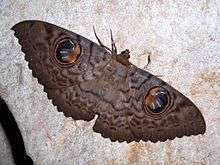Erebus (moth)
Erebus is a genus of moths in the family Erebidae.
| Erebus | |
|---|---|
 | |
| Erebus macrops | |
 | |
| Erebus ephesperis | |
| Scientific classification | |
| Kingdom: | Animalia |
| Phylum: | Arthropoda |
| Class: | Insecta |
| Order: | Lepidoptera |
| Superfamily: | Noctuoidea |
| Family: | Erebidae |
| Tribe: | Erebini |
| Genus: | Erebus Latreille, 1810[1] |
| Synonyms | |
| |
Taxonomy
The genus is the type genus of the tribe Erebini, subfamily Erebinae, and family Erebidae.
Description
Differs from Speiredonia in the mid and hind tibia being spined and almost naked. Forewings are broad.[2]
Species
- Erebus acrotaenia (Felder, 1861)
- Erebus acuta (Fawcett, 1917)
- Erebus aerosa (Swinhoe, 1900)
- Erebus albiangulata (A. E. Prout, 1924)
- Erebus albicinctus (Kollar, 1844) (syn: Erebus obscurata (Wileman, 1923), Erebus rivularis Westwood, 1848)
- Erebus atavistis (Hampson 1913)
- Erebus candidii (Strand 1920)
- Erebus caprimulgus (Fabricius, 1775)
- Erebus clavifera (Hampson, 1913)
- Erebus crepuscularis (Linnaeus, 1758) (syn: Erebus obscura (Bethune-Baker, 1906) )
- Erebus cyclops (Felder, 1861)
- Erebus ephesperis (Hübner, 1827)
- Erebus felderi (A. E. Prout, 1922) (syn: Erebus seistosticha (A. E. Prout, 1926))
- Erebus gemmans (Guenée, 1852)
- Erebus glaucopis (Walker, 1858) (syn: Erebus prunosa (Moore, 1883))
- Erebus hieroglyphica (Drury, 1773) (syn: Erebus celebensis (Hopffer, 1874), Erebus hermonia (Cramer, 1777), Erebus lunaris (Walker, 1864), Erebus mygdonia (Cramer, 1777), Erebus tenebrata (L. B. Prout, 1919), Erebus ulula (Fabricius, 1775))
- Erebus illodes (Zerny, 1916)
- Erebus intermedia (Pagenstecher, 1900)
- Erebus ipsa (Swinhoe, 1918)
- Erebus jaintiana (Swinhoe, 1896)
- Erebus lombokensis Swinhoe, 1915
- Erebus macfarlanei (Butler, 1876)
- Erebus macrops (Linnaeus, 1768)
- Erebus maurus (Gaede, 1917)
- Erebus mirans A. E. Prout, 1932
- Erebus nyctaculis (Snellen, 1880)
- Erebus orcina (Felder and Rogenhofer, 1874)
- Erebus pilosa (Leech, 1900)
- Erebus purpurata (Druce, 1888) (syn: Erebus aroa Bethune-Baker, 1908)
- Erebus strigipennis (Moore, 1883)
- Erebus sumatrensis (Hampson, 1913)
- Erebus sumbana (Swinhoe, 1918) (syn: Erebus ceramica (Swinhoe 1918), Erebus luzonica (Swinhoe, 1918))
- Erebus superba (Swinhoe, 1908)
- Erebus terminitincta (Gaede, 1938) (syn: Erebus variegata (Swinhoe, 1900))
- Erebus variegata (Butler, 1887)
- Erebus walkeri (Butler, 1875) (syn: Erebus valceri (Hampson, 1913))
Former species
- Erebus javanensis (Hampson, 1913)
- Erebus moriola (Swinhoe, 1918)
- Erebus orion (Hampson, 1913)
- Erebus oxodoxia (Swinhoe, 1918)
gollark: 🐝 ❕
gollark: Bee you.
gollark: I disagree somewhat with your disagreement. The memes you see have been filtered through a lot of people and websites before reaching you and ones which weren't sufficiently memey weeded out. Popular memes provide some insight into what people like.
gollark: This is also deductive, not inductive.
gollark: I don't think this is technically correct either. They can manipulate quantum states in various ways to do some operations faster, not magically accelerate everything.
References
- Yu, Dicky Sick Ki. "Erebus Latrielle 1810". Home of Ichneumonoidea. Taxapad. Archived from the original on January 15, 2019. Retrieved January 14, 2019.
- Hampson, G. F. (1894). The Fauna of British India, Including Ceylon and Burma: Moths Volume II. Taylor and Francis – via Biodiversity Heritage Library.
| Wikispecies has information related to Erebus (moth) |
| Wikimedia Commons has media related to Erebus (moth). |
External links
- Savela, Markku. "Erebus Latreille, 1810". Lepidoptera and Some Other Life Forms. Retrieved January 14, 2019.
- Naturhistoriska Riksmuseet (in Swedish)
This article is issued from Wikipedia. The text is licensed under Creative Commons - Attribution - Sharealike. Additional terms may apply for the media files.